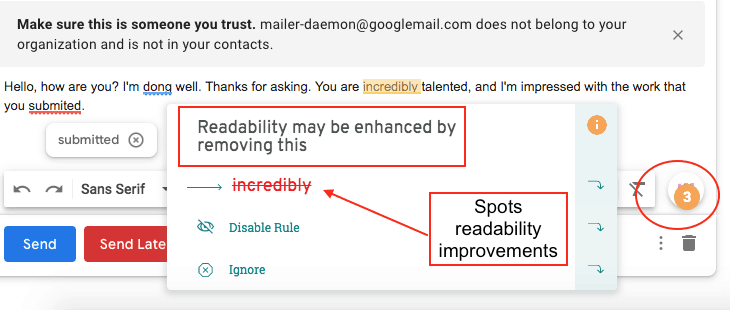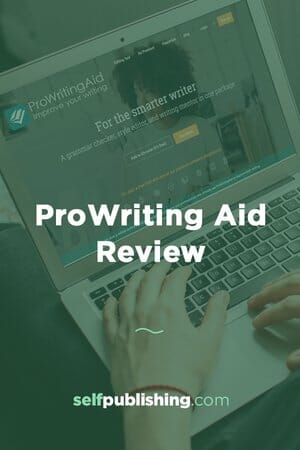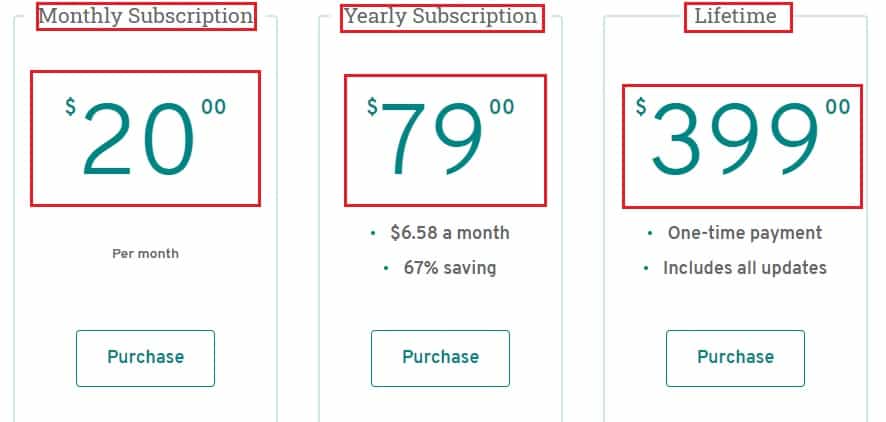ProWritingAid claims to be a complete, all-in-one package with the ability to check grammar, edit style, and be a writing mentor. Does it live up to its claim?
Because we’re always on the hunt for smart technology to help us improve our writing, ProWritingAid’s use of artificial intelligence (AI) to create a comprehensive writing tool has caught our attention.
When we’re self-publishing a book, our to-do lists often seem overwhelmingly long – from writing a book to publishing the book, then marketing it and staying on top of legal and financial responsibilities.
Given the epic scope of our tasks, it’s no wonder we look to book writing software and writing apps to provide a helping hand.
One such service is ProWritingAid. It’s similar to alternatives such as Grammarly because it claims to use AI and innovative tech to help you write better.
But does this tool actually do all that it claims to? In this ProWritingAid review, you’ll learn exactly what the tool does, how it measures up against similar tools, and how to decide if it is right for you.
We want you to make informed decisions when it comes to how and where to invest your money. That’s why our mission is to help educate authors on the various self-publishing companies and services that are on the market today.
Our reviews are meant to be unbiased, 3rd party reviews, but we will speak up if there is a scam or a clearly better option.
What is ProWritingAid?
Before delving deep into the tool’s capabilities, it’s important to understand what ProWritingAid is.
The original purpose of the tool was to make a manuscript or book better before it received the attention of a human editor. So quite literally, it was designed to be a pro writing aid.
First of all, let’s be clear. A human editor is an invaluable resource that won’t be bettered or even matched by AI in the foreseeable future.
However, while book editors make the best authors even better, their talents are often wasted.
As writers, we have inevitable blind spots when it comes to our mistakes and errors. Just because we can’t see our errors, it doesn’t exactly require Maxwell Perkins to spot them.
That’s where ProWritingAid comes into play. It offers an impeccable level of automated editing before a human takes over.
But why is this worth investing in? Do Google Docs and Microsoft Word also not catch the glaring errors we all make?
The tool claims to be capable of more than simply catching your mistakes. It also seeks to assess and improve your writing style.
Let’s see exactly how.
What does ProWritingAid do?
The features listed on the ProWritingAid website are impressive. In addition to specific functions the tool uses to help improve writing, it also uses analytical reports to take a closer look at your work.
The tool goes beyond spelling and grammar checks. In fact, it looks at a variety of different aspects of writing, including style, readability, repetition, and more.
Here are some of the features of ProWritingAid:
- Checks for consistencies in spelling, hyphenation, and capitalization
- Identifies clichés and redundancies
- Checks for grammar and spelling mistakes
- Looks for terminology errors
- Can be used as a contextual thesaurus
- Checks for plagiarism
- Improves readability
- Identifies repetitive and overused words and phrases
- Improves paragraph structure
- Looks for vague and/or complex words in your writing
Now that you have an overview of the ways in which this tool can improve your writing, let’s take a closer look at how it analyzes your writing through its in-depth reports.


How to use ProWritingAid to improve your writing
Have you ever been let down by marketing hype?
It’s easy to get excited by slick promotional efforts and start to put undue amounts of faith in a product or service.
This is all the more true when big claims are being made by a product’s creators. And, in their own words, the creators of this pro writing aid tool promise to “help you achieve new heights” and claim their app is “a grammar checker, style editor, and writing mentor in one package.”
If you’ve ever sought out an excellent editor or writing mentor, you’ll know they’re not exactly a dime a dozen. So is this tool promising too much by claiming to be these things?
Let’s go beyond the language the tool uses to describe its benefits and take a cold look at what it tangibly does for your writing.
Regardless of whether you choose to use this tool as a standalone online service, browser plugin, or desktop app, the experience of using it boils down to the following three options:
- Online service: Go to the ProWritingAid website and use the program from any device that has internet access.
- Browser plugin: Download the browser plugin, so that the tool is working in the background whenever you are typing into your chosen browser.
- Desktop app: Download the desktop app and access the program without needing a browser open, so that you can check your writing without the distraction of the online world.
So what feedback does this writing tool provide, and how does this make you a better publisher?
How to use ProWritingAid reports
When you run a piece of writing through this pro writing tool, it analyzes it in over 20 different ways. You’ll receive automated feedback on the following aspects of your work.

Here are the 20+ factors analyzed in the report:
Writing style
Seeing as style is so subjective, can software genuinely analyze it in any meaningful way?
ProWritingAid identifies many of the writing sins that are commonly warned against, such as excessive use of passive verb forms or reliance on adverbs.
Grammar
Sometimes, we get so absorbed in the idea we wish to convey through our language that we lose sight of the grammatical rules it must conform to. This tool not only spots your grammatical mistakes – it teaches you the underlying rules to deepen your knowledge.
Overused words
As subjective, creative beings, we aren’t aware of the routine flaws in our work. Almost every writer has a set of words they overuse without meaning to. The tool identifies if you use certain words too frequently, allowing you to consider better alternatives.
Cliche and redundant language
What ProWritingAid considers redundant language, you might see as a stylistic choice. By allowing the app to identify potential cliches and tautology in your work, you prevent any slipping through by accident.
Glue words
This pro writing tool considers words such as ‘and’, ‘in’, and ‘of’ to be glue words – they ensure a sentence sticks together, but don’t particularly enrich it. Identify how many glue words you are using and whether any can be eliminated for more succinct sentences.
Readability stats
If you want to know the Flesch Reading Ease score for your work, ProWritingAid gives you exactly that. Ensure your language is suitable for its intended audience.
Repetitive language
With over 170,000 words in the English language, there’s no need to be repetitive. However, when absorbed in a creative flow state, we can use the same words or phrases unknowingly. This pro writing tool catches your repetitive language before it annoys your editor or reader.
Sentence length
Many consider varied sentence lengths to be characteristic of proficient writing. ProWritingAid analyzes how long your sentences are to help you avoid a boring lack of variety.
Pronoun usage
Excessive pronoun use can annoy readers. This writing tool believes a 4-15% level of pronoun usage is suitable. The software highlights your pronoun usage percentage, so you can consider adjusting it.
Transitions
Want to know how often your sentences should contain transitional language such as ‘nevertheless’ or ‘as a result’? 25% or more of the time, according to ProWritingAid. A lack of transitional language is one of the many flaws the app is capable of identifying.
Consistency
Inconsistency can spoil otherwise excellent writing. If you are inconsistent in your use of contracted language, or regional spelling, this tool will let you know. This is particularly helpful for collaborative work, especially that carried out by remote teams.
Pacing
The pacing report is an example of the tool going beyond simple grammar and spelling checks. If the app feels you have too many slow-paced sections, it will highlight this issue for your attention.
Dialogue tags
Although a matter of personal preference, it’s often said that dialogue tags should be restricted to “said”. ProWritingAid conveniently highlights every dialogue tag you’ve chosen, to help you make adjustments where needed.
Contextual thesaurus
If you’ve ever tried to use overly fancy language suggested by a thesaurus, you’ll know it’s a risky move. If you’re not familiar with a suggested word, it’s impossible to know whether it’s contextually suitable. A full contextual thesaurus is fully integrated into this pro writing tool.
Diction
Do you fall victim to verbosity? ProWritingAid identifies areas where you are being wordy and suggests punchier alternatives.
Alliteration
Alliteration is a little like spice. The right amount can add flavor to your language, while too much can overwhelm and annoy. Identify your uses of alliteration to help find the right level for your work.
Homonyms
Homonyms can crop up due to tiredness or even through errors with voice-to-text software. This writing tool points out all your homonymic language so you can avoid any humiliating mishaps.
Acronyms
Acronyms are tricky – they fly under the radar of many grammar and spelling checkers, but also destroy credibility if used poorly. Ensure acronym accuracy with this pro writing aid.
Multisyllabic words
If you use too many words of three or more syllables, it might annoy or repel your readers. This tool will identify each use of trisyllabic language and suggest a simpler alternative.
Bespoke style
Want to create a custom style guide for a particular writing project? It’s easy to do this with ProWritingAid, ensuring you’re beholden to no rules other than the ones you wish to be.
Plagiarism check
Perhaps you’re sourcing written content from multiple authors or ensuring academic rigor. Regardless of why, if in-depth plagiarism checking is something you need, this writing tool offers it.
Overall, the ambition and scope of ProWritingAid’s reports are impressive.
While the insight on offer isn’t a match for an experienced editor, it isn’t intended to be.
Instead, think of the array of reports as quantitative, granular insight into your work. Raw clay for a human mind to shape into something meaningful.
By focusing on technicalities such as the percentage of pronouns you use, this writing tool frees up your heart and mind to focus on something much more meaningful – your message.
Related:
Using ProWritingAid with other publishing tools
As writers, we can be creatures of habit. Switching writing systems and tools away from those we are accustomed to is often incredibly unappealing. Just ask George R.R. Martin.
If you’ve taken the time to develop a process and already have your favorite book writing software, you might be hesitant to add ProWritingAid into the mix.
After all, new software takes time to learn. Time that could be spent writing.
Thankfully, this writing tool is more than capable of working with your existing writing tools, rather than requiring you to discard them.
The good news is that this tool is versatile, and can function with other popular tools out there.
- Firefox. While you’re probably not composing your next novel in Firefox, you can benefit from ProWritingAid’s analysis with this browser add-on.
- Chrome. Leaving a blog comment using Chrome? Avoid any language mishaps with the ProWritingAid Chrome extension.
- Safari. If you prefer Apple’s default browser, you can still combine it with ProWritingAid.
- Google Docs. Google Docs is one of the most convenient writing solutions out there. That doesn’t mean its users need to compromise on power. If you use the browser extension, then you won’t be able to use ProWritingAid with Google Docs directly. You’ll simply have to integrate the tool into the ‘add-on’ menu of Google Docs, and the process is easy (pop-ups will appear to guide you).
- Microsoft Office. If you use Word or Outlook as part of your writing work, this writing tool integrates directly into Microsoft’s popular products.
- Scrivener. Scrivener is a heavyweight software solution for serious writers. If you’ve taken the time to learn its complexities, save yourself the trouble of yet another learning curve by integrating ProWritingAid into Scrivener.
There’s no one best way to write and edit your book. Some writers like to write and edit in a single software environment, others prefer a change of scenery.
The fact that ProWritingAid is capable of integrating with existing tools writers love, such as Scrivener, is a major plus point.
You don’t have to come up with a new publishing process to use the app. It fits in with the way you like to do things.
The pros and cons of ProWritingAid
So when it’s all said and done, what are the pros and cons of using this writing tool?
There are a number of benefits, as well as areas for improvement, when it comes to this writing tool.
The pros of using ProWritingAid:
- Scope. If you want to delve deeper than a red line under a grammatical error, ProWritingAid is the tool for you. Deepen your love of language by learning its intricate details within the app.
- Value. This tool does a lot more than other tools on the market, while costing a lot less.
- Ease. Use this writing tool online, or as a desktop app, or as an integration for a tool you already love. Its flexibility and ease of use will appeal to many.
The cons of using ProWritingAid:
- Plagiarism. To carry out plagiarism checks with ProWritingAid, you need to spend extra. If plagiarism checking is one of your main needs from the app, consider whether it represents the best value for you.
- It’s not really a mentor. This tool does many things to make your writing life easier and less stressful. But does it live up to its claim of being a mentor? No.
- No substitute. Don’t think of this tool as some sort of hack or shortcut. It can highlight areas of improvement in your writing, and help you understand why they matter, but you still need discernment and experience to put its suggestions into practice.
How much does ProWritingAid cost?
ProWritingAid is free with limited access, or $79 offers full access with a paid subscription.
Depending on how many years you want the tool, there are various pricing packages to choose from if you’re interested in purchasing the Premium versions.
- Free. A restricted version of ProWritingAid, offering only online access and a restricted word count.
- 1-Month Premium. $20 for a full month of Premium access.
- 1-Year Premium. $79 for a full year of ProWritingAid Premium.
- Lifetime. $399 for lifetime access to ProWritingAid.

Is ProWritingAid free?
If you want to see everything ProWritingAid is capable of before spending a cent, reach out and request a 14-day trial.
This is the best way to get hands-on and see if this tool represents a worthwhile investment for your writing process or not.
Is ProWritingAid right for you?
If you’re looking to automate and improve your self-editing process, ProWritingAid is definitely worth your time.
The features on offer feel well-considered and genuinely valuable to writers. The affordability of the app is also a big plus point for frugal authors.
I love the fact that this writing tool is as helpful as you need it to be. The app is equally capable of preventing you from an embarrassing grammar error in your next email as it is of analyzing every last dialogue tag in your 500,000-word epic novel.
What are you looking for in a writing tool?
Looking to replace the wisdom and guidance of a human editor? It can’t be done. No writing software, ProWritingAid or anything else, is capable of this.
But if you’re looking to make your life as a pro writer more enjoyable and less tedious, you owe it to yourself to check out ProWritingAid.
If you like this review, here are some other writing tool reviews to check out!


























